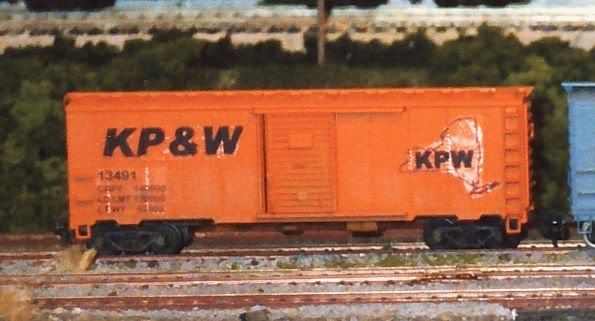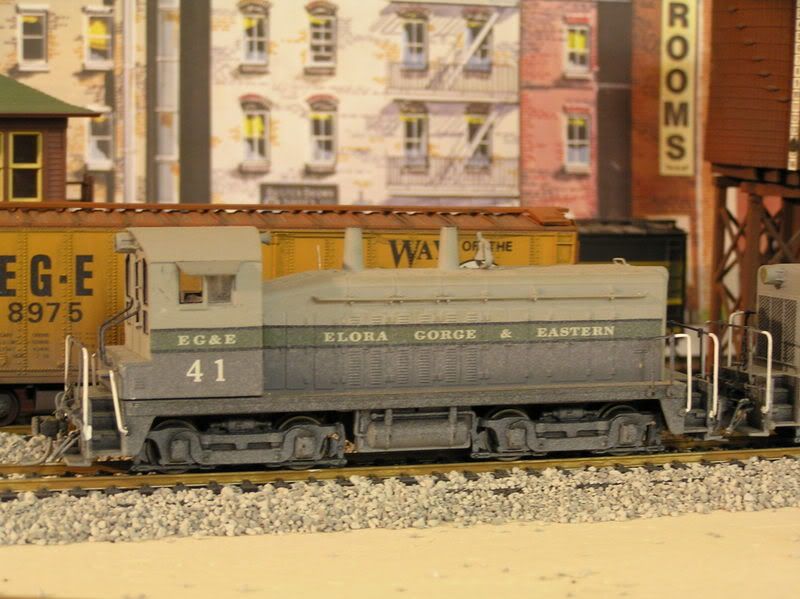Thanks for the kind words.
Wayne, did any of those roads survive into the 1970s?
Does the Grand River Southern have its own boxcars?
Gary, I used to have an extensive collection of '70s equipment, including diesels, passenger cars, and freight cars. I keep an all-time roster, to ensure that I don't duplicate any car numbers. My good friend cnnutbar may be able to provide pictures of a couple of the modern boxcars, but most were sold through a local hobbyshop (and went rather quickly, I'm pleased to say), so I have no way of knowing which ones are still in use or even in existence. My good friend Deano has the EG&E's U-boats. :thumb: The Grand River Southern owns only the diesel shown, although I may letter that Bachmann 2-6-6-2 that I purchased a while back for the same road, and perhaps build a caboose. I decided on the roadname when I drew the original trackplan for my layout. The premise was that the EG&E was a successful bridge line that ran generally north-south along the east bank of the Grand River. Rival Grand Valley (Central), on the west bank, was less successful, and the EG&E eventually bought controlling interest in the line, from then-owner NYC. The plan was to upgrade the Grand Valley as a secondary mainline of the EG&E, and the Grand River Southern was created as a transfer road: its sole purpose was to move freight from the EG&E's southern yard on the east side of the river to the Grand Valley's southern yard on the west side. The original layout called for staging to represent the EG&E's portion, with the GVC's yard actually modelled. Connection would be via an approximately 12' long multiple-span bridge of the modelled river. My current lower staging represents all three parts of the original plan.

There are no freight cars lettered for the GRS.
Anyway I could procure decals for your Erie Northshore?
Miles, the Erie Northshore (the full name is Grand River & Northern Lake Erie) is jointly-owned by the EG&E and GVC. It provides an interchange with the prototype TH&B at Port Maitland, and was built in the early 1900s to service the flux industry in Port Maitland. Later, it became part of a link in the delivery of coal to a power plant in Mount Forest. The line owns only its own locomotives and cabooses. All rolling stock is provided by the parent companies.
The EG&E has a full complement of all types of freight and passenger cars, and owns all M0W equipment used on any of the lines. The Grand Valley has a medium-size roster of passenger and head-end equipment, in addition to its locomotives and cabooses, and also a handful of wooden boxcars and a few stockcars. The bulk of its freight cars are hoppers for use in the powerplant service. Many of them are re-lettered EG&E cars.
The lettering for the EG&E freight cars is all custom dry transfers from C-D-S, obtained in three separate (and different) orders. The last order included lettering for Grand Valley freight cars. This is basically reporting marks, numbers, and dimensional data in a different font than that used by the EG&E. There is also a herald, which is the same as the EG&E's except for the lettering. All passenger car lettering was done with dry transfer alphabet sets (next time I'll pick shorter roadnames

)
Except for the EG&E Mohawk shown in the first picture, all locos of all other roads were lettered with dry transfer alphabet sets and striping, used as painting "masks": in other words, the lettering is painted-on. With the exception of Deano's U-boats, all of the older (but more modern) EG&E diesels were done with alphabet set decals from Champ.
So, to finally answer both questions, no cars owned by the Grand River Southern or the Erie Northshore, and also no specific lettering available for either.
Once again, sorry to go on at such length, but the history played a part in the development of the roadnames and the operating system. In my original post, I neglected to mention some other free-lanced roadnames that I have, or had, in service. These include Elora Produce Distributors (EPDX):
Grand Valley Export (GVEX): (just the car to the right)
and GERN Industries Limited (GILX)
EPDX was later merged into GVEX, as both, similar to PFE or FGE, provided reefers to their respective parent companies. GILX continues to serve the North American flux industry.
Wayne


























